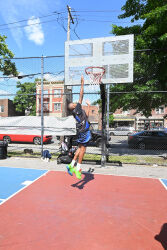Castle Hill Playground
Castle Hill Playground
This playground, like the adjacent school, takes its name from the surrounding neighborhood, Castle Hill. The area was named by Adriaen Block, a 17th century New Netherland Company explorer, who thought that a fortified Siwanoy Indian village in the area resembled a castle. Additionally, Castle Hill Avenue was originally a path used by the Siwanoy as early as 700 A.D.
Bound by Westchester Creek to the east and Pugsley Creek to the west, the peninsula of Castle Hill Neck was first settled in 1685 by John Cromwell, a cousin of Oliver Cromwell, the famed Puritan statesman and Lord Protector of England, Scotland, and Ireland. John Cromwell's father, Colonel John Cromwell served in the Puritan forces, fighting against the Royalist army during the English Civil War. When the Puritans planned the execution of King Charles I, Colonel Cromwell spoke out against this extreme action. Serving as an emissary of Prince William of Orange, the ruler of the Netherlands, Colonel Cromwell delivered a plea to his kin, Oliver Cromwell, for the king's life. When the Lord Protector rejected the plea, Colonel John Cromwell fled in fear to the Netherlands. His son, John Cromwell, eventually settled along with other Puritans in what is now the Bronx.
The South Bronx, called Vredelandt (free land) by the Dutch authorities, was open to settlers of all nationalities and religions. Shortly after their arrival in Vredelandt, English settlers established the town of Westchester, centered along Westchester Creek near what is now Westchester Square. The town of Westchester, which included Castle Hill Neck, was so named because it occupied the westernmost point of English settlement on the American continent at the time.
Castle Hill Neck was owned by the Cromwell family until the late 1700s, during which time the area was known as Cromwell's Neck. In 1800, the land passed to the Reverend Isaac Wilkins, the minister of St. Peter’s Church on Westchester Avenue, and remained in his family for several generations.
During the Revolutionary War, the Castle Hill area was owned by wealthy landowner and politician Gouverneur Morris Wilkins, who constructed a home at what is known today as Castle Hill Point. In 1775, Wilkins was elected as a delegate to New York's Revolutionary Provincial Congress, where he helped to draft the first constitution of the State of New York. The statesman's property was passed down to his son-in-law John Screvin, who sold plots for development in what would become the present-day Castle Hill area.
After the dissolution of the Wilkins estate, Castle Hill Neck consisted primarily of small houses and truck farms. In the 1950s, many of these smaller properties were replaced with large public housing projects.
The property on which this playground stands, bounded by Castle Hill Avenue, Parker Street, and Purdy Street, was acquired by the City on March 11, 1954, and the park opened on May 29, 1957. Jointly operated by the Board of Education and Parks, the playground provides students and nearby residents with spaces designed for basketball, softball, roller-skating, handball, and shuffleboard.
Castle Hill Playground is also used by several after-school and community programs. The Champions’ Club organizes events including tennis, track and field, and softball for neighborhood children in the spring and fall. Another program, The Big Apple Games, provides a similar recreational program for area children during the summer.
In 2001, Commissioner Stern gave the playground its present name. That same year, a $1.1 million reconstruction funded by Council Member Lucy Cruz was completed. The renovation concentrated on upgrading the play equipment and modernizing the site.
Check out your park's Vital Signs
Clean & Safe
Green & Resilient
Empowered & Engaged Users
Share your feedback or learn more about how this park is part of a
Vital Park System







